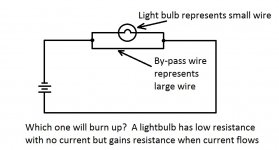tallgirl
Senior Member
- Location
- Glendale, WI
- Occupation
- Controls Systems firmware engineer
I was responding to Sea Nile's comment.I do not think that the effect of conductor heating is significant enough to seriously affect current distribution and heating.
Just note that the ampacity of the pair of non-identical wires will probably be less than the sum of the two independent ampacities because of the difference ratios between resistance and heat dissipation.
Anything other than equal current distribution over equal conductors will end up with the current distribution NOT matching the relative ampacities. No opinion on which conductor will be more stressed at this point. Have to think more about it. Probably the larger one.
It's very unlikely that a simple analysis will reflect what's going to happen because each wire will change its behavior as the other changes its. The temperature coefficient of resistance for copper is about 0.4% / *C. That's a non-trivial change, but the question would be under what circumstances would the temperature of one conductor be significantly different from the other. Were I doing any kind of calculation to figure out how the currents are distributed I'd pick the extremes for both temperature and current and ensure that both conductors were within their rated ampacities over that entire range.


